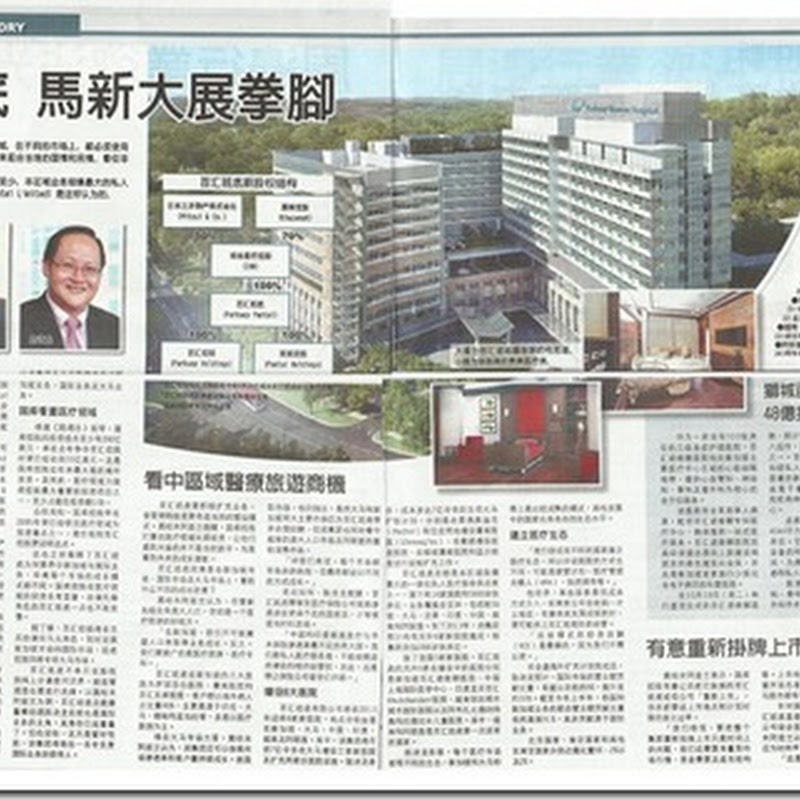MCIL’s profit may overtake Star’s by FY11 ending March 31. For 9MFY11, MCIL’s net profit rose 48.6% to RM139 million from RM93.5 million a year earlier.
MCIL is the publisher of local Chinese papers such as Sin Chew Daily, Nanyang Siang Pau, China Press and Guang Ming Daily, as well as Ming Pao in Hong Kong.
MCIL’s earnings are expected to soon overtake that of industry leader Star.
The English market is already saturated. At the same time, MCIL is already a market leader of the local Chinese print media with growing and loyal Chinese readership.
MCIL is the publisher of local Chinese papers such as Sin Chew Daily, Nanyang Siang Pau, China Press and Guang Ming Daily, as well as Ming Pao in Hong Kong.
MCIL’s earnings are expected to soon overtake that of industry leader Star.
The English market is already saturated. At the same time, MCIL is already a market leader of the local Chinese print media with growing and loyal Chinese readership.
The English print media has been challenged by the proliferation of free alternative news providers on the Internet while local Chinese-based alternative news is scarce.
There are very few Chinese blogs or news portals online compared with English sites. As such, MCIL should see its readership grow or maintain. On the other hand, more people are going online to obtain English news, which leads to declining circulation in the English print medium.
For FY10, MCIL recorded a net profit of RM134.2 million or 7.96 sen a share. It also recently distributed 50% of its profits, or 3.98 sen per share, as dividends to its shareholders. MCIL’s earning also grew 48.7% year-on-year for its 9MFY11 compared with Star’s slower growth of 27.8% for FY10.
MCIL has strong balance sheet with RM272 million cash and no borrowings.
In only two years since MCIL emerged as part of a merger in 2008, its net profit had soared 118% to RM134.2 million in FY2010.
There are very few Chinese blogs or news portals online compared with English sites. As such, MCIL should see its readership grow or maintain. On the other hand, more people are going online to obtain English news, which leads to declining circulation in the English print medium.
For FY10, MCIL recorded a net profit of RM134.2 million or 7.96 sen a share. It also recently distributed 50% of its profits, or 3.98 sen per share, as dividends to its shareholders. MCIL’s earning also grew 48.7% year-on-year for its 9MFY11 compared with Star’s slower growth of 27.8% for FY10.
MCIL has strong balance sheet with RM272 million cash and no borrowings.
In only two years since MCIL emerged as part of a merger in 2008, its net profit had soared 118% to RM134.2 million in FY2010.
Following the merger of Sin Chew, Nanyang and Ming Pao in 2007, MCIL has become a global Chinese language media group with operations spanning Southeast Asia, Greater China as well as North America.
Based on the results for the nine months of its current financial year, the non-Malaysian operations accounted for 39% of the group’s revenue and 17% of the group’s pre-tax profit.
Ming Pao’s flagship newspaper, Ming Pao Daily News in Hong Kong, has its separate editions published in Toronto and Vancouver. In Hong Kong, Ming Pao is ranked No 3 in terms of circulation (approximately 441,000 a day) and was named the “Most Credible Chinese Newspaper” by the Media Creditability Survey in 2009. The newspaper is well-known for its comprehensive reports on political and economic issues. Newspapers currently command 32% of adex market share in Hong Kong.
Ming Pao Daily News’ Toronto and Vancouver editions have circulations of approximately 160,000 a day, and the newspaper is doing well as it caters to large migrant Chinese communities.
MCIL management remains optimistic that demand for digital content will pick up on the back of rising broadband penetration and the growing population of smart devices.
The group made two notable acquisitions in its push to entrench itself further in the digital-media space and has seen the acquisitions become fruitful.
Management has guided that the total capex spent on expanding its digital media is said to be minimal (approximately HK$3 million (RM1.17 million) to HK$5 million a year) as the group continues to keep a look-out for potential M&A opportunities in order to expand its reach in Hong Kong and China’s digital media market.
Based on the results for the nine months of its current financial year, the non-Malaysian operations accounted for 39% of the group’s revenue and 17% of the group’s pre-tax profit.
Ming Pao’s flagship newspaper, Ming Pao Daily News in Hong Kong, has its separate editions published in Toronto and Vancouver. In Hong Kong, Ming Pao is ranked No 3 in terms of circulation (approximately 441,000 a day) and was named the “Most Credible Chinese Newspaper” by the Media Creditability Survey in 2009. The newspaper is well-known for its comprehensive reports on political and economic issues. Newspapers currently command 32% of adex market share in Hong Kong.
Ming Pao Daily News’ Toronto and Vancouver editions have circulations of approximately 160,000 a day, and the newspaper is doing well as it caters to large migrant Chinese communities.
MCIL management remains optimistic that demand for digital content will pick up on the back of rising broadband penetration and the growing population of smart devices.
The group made two notable acquisitions in its push to entrench itself further in the digital-media space and has seen the acquisitions become fruitful.
Management has guided that the total capex spent on expanding its digital media is said to be minimal (approximately HK$3 million (RM1.17 million) to HK$5 million a year) as the group continues to keep a look-out for potential M&A opportunities in order to expand its reach in Hong Kong and China’s digital media market.













































